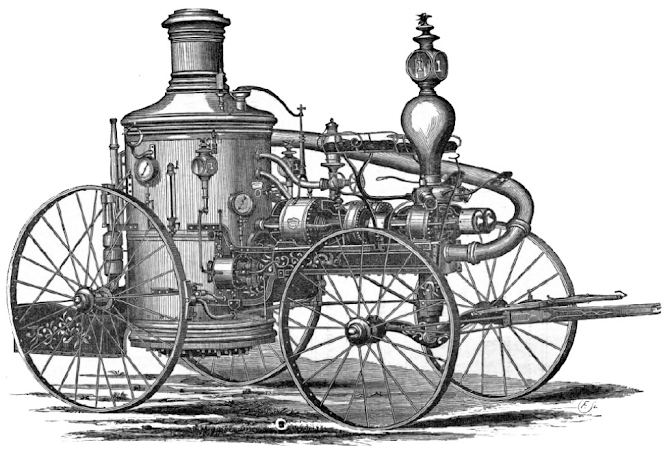At about half past six o'clock, Mr. P.B. Lamb's planning mill, corner of Fulton and Jefferson streets, caught fire, and in a few moments, the entire building was wrapped in flames.
 |
| The Number 1, Long John Steamer, was put into service in Chicago in 1858. It was the first steam fire engine in the city, and it helped to revolutionize the way that fires were fought. It was a 40-foot long, 14-foot high, and 8-foot wide vehicle. It weighed 10 tons and was powered by a 100-horsepower steam engine. The Long John could pump 500 gallons of water per minute. |
Mr. Lamb's loss is $6,000, on which he had no insurance. In the lumber yard adjoining the mill, Mr. H.M. Lewis lost $1,500 worth of lumber, which he is covered by insurance for $1,300 by Home Insurance of New York. The Galena and Chicago Union Railroad also lost $60 worth of lumber, and Mr. Walter Lull lost $160 worth.
Adjoining the yard on the south were two two-story frame buildings, № 62 and № 60 Jefferson Street, owned by D.L. Jacobus & Co. and occupied by them as a furniture store and warehouse. Most of the furniture was saved, but the buildings were totally destroyed. A large quantity of hard lumber owned by this firm was burned. The large four-story brick furniture factory, № 56 Jefferson Street, owned and occupied by Jacobus & Co., was on fire a number of times and was considerably damaged by fire and water, as is also the machinery. This firm loses some $7,500, against which there is an insurance policy of $4,500 with the Hartford Insurance and Philadelphia Insurance companies.
On the alley, in the rear of Jacobus & Co., premises, which were burned.
Mr. Burk's flour and feed store was badly scorched, and his barn burned.
The buildings on the opposite sides of the street were considerably scorched, and at one time, there was great danger that the fire would cross the street.
The whole loss is not far from $15,000.
Compiled by Dr. Neil Gale, Ph.D.


